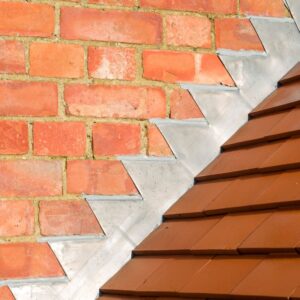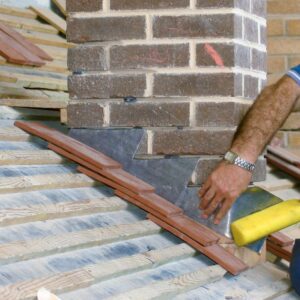Chimney construction seems rather simple from the outside, right? Comprising a firebox on the inside and a tunnel system connecting that indoor firebox to the outside world, they are visually straightforward. Yet, whether brick, prefabricated, or some other structure designed to release the byproducts formed when heat is created, there is much more to the chimney system that meets the eye. Many of the most vital components of any chimney structure are either hidden within or deceivingly miniscule.
What do we mean? Take flashing, for example. Unless you’re regularly inspecting roofs or spending a lot of time craning your neck to investigate the chimneys in your area, there is a high chance you might not even notice the metal shingle-like material between the base of your chimney and the roof of your home.
Did you know that the flashing plays a huge role in protecting both your chimney and your home from water intrusion and eventual deterioration?
If you’re a homeowner in Benton County, AR or Greene County, MO and you have questions about chimney flashing (or anything else vent-related), there is no crew better than Ozark Stove & Chimney to call on. Our technicians are friendly, incredibly knowledgeable, and certified. Give us a call at 417-201-6585 or reach out online to see how we can assist you.
How Does Flashing Protect Against Water Damage?
When you think of how important chimney flashing is in maintaining the integrity of both your home and chimney, it’s rather interesting to note that it is hardly even noticed by the majority of the population.
What is flashing?
 Regardless of the specific “type” (more on that a bit later), flashing is constructed from sheet metal and is installed as a weather/waterproofing agent wherever there is a penetration through the roof: the chimney, other piping/vents, skylights, etc.
Regardless of the specific “type” (more on that a bit later), flashing is constructed from sheet metal and is installed as a weather/waterproofing agent wherever there is a penetration through the roof: the chimney, other piping/vents, skylights, etc.
So, how exactly does chimney flashing work?
Because your roof and your chimney are made of different materials, they contract and expand with the weather and temperature changes at different rates. This creates gaps and separations where water can leak in, damaging your ceiling and the base of the chimney.
Depending on the location of the flashing, the material and method may differ slightly, but the purpose is always to seal off the opening and ensure your home is protected from rainfall, melting snow, and other water damage or leaks.
Are There Different Types of Chimney Flashing?
Yes, there are – both in material and method of installation. For chimneys specifically, the following three types of flashing are necessary in order to create a watertight seal:
- Step flashing: Shaped like an elongated metal shingle bent into an “L,” this type of flashing is placed under the roof shingles and up against the base of your chimney on all sides
- Counter (sometimes called “cap”) flashing: Installed as a second layer on top of the step flashing, counter flashing acts as added protection – it is designed to be inserted into the brick of the chimney.
- Base flashing: This layer ensures that the barrier created between the chimney and the roof is reinforced and impenetrable. It is installed around the base of the chimney.
As far as materials, similar to other metal-based chimney parts, there are several that are commonly used:
- Aluminum
- Varieties of metal (including stainless, galvanized, and aluminum)
- Copper
The two that are used the most are aluminum and stainless steel, as the former is lightweight and easily moldable, while the latter is a bit sturdier and more durable, and has a longer lifespan.
When it comes to choosing what flashing is best for your Southwest Missouri or Northwest Arkansas home, trust Ozark Stove & Chimney to help you from beginning to end. Schedule an appointment online today!
What Are the Signs of Damaged or Faulty Chimney Flashing?
Damaged chimney flashing is one of the most common causes of chimney leaks and eventual water damage. It’s recommended that you have your chimney professionally inspected every year, but that doesn’t guarantee that something might not occur later in the year or at the start of the burning season.
 That said, here are some signs to look for if you are worried about the state of your chimney flashing:
That said, here are some signs to look for if you are worried about the state of your chimney flashing:
- Water damage to your ceiling near the fireplace or home heating appliance
- Leaking or dripping water inside your fireplace or wood stove
- Discoloration in the brickwork of your chimney
- Gaps or openings in the caulking between the flashing and the chimney
Call Us Today – Don’t Delay!
If you’ve noticed any of these signs, or find that you have other chimney-related questions or concerns, don’t hesitate to reach out to someone on our team. Here at Ozark Stove & Chimney, we aim to make your chimney experience as pleasant and seamless as possible. Book online or call us at 417-201-6585 to learn more. We look forward to serving you.
